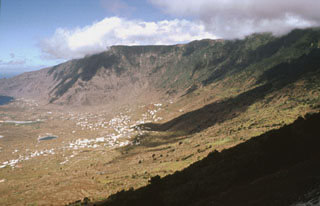Report on Hierro (Spain) — 19 October-25 October 2011
Smithsonian Institution / US Geological Survey
Weekly Volcanic Activity Report, 19 October-25 October 2011
Managing Editor: Sally Sennert.
Please cite this report as:
Global Volcanism Program, 2011. Report on Hierro (Spain) (Sennert, S, ed.). Weekly Volcanic Activity Report, 19 October-25 October 2011. Smithsonian Institution and US Geological Survey.
Hierro
Spain
27.73°N, 18.03°W; summit elev. 1500 m
All times are local (unless otherwise noted)
Instituto Geográfico Nacional (IGN) reported that during 19-25 October tremor continued to be registered by every seismic station on El Hierro Island; 270 seismic events were registered and located. The mean amplitude was lower than during previous days but indicated that the submarine eruption continued. Since 21 October, most of the events were located in the N part of the island, aligned NNW-SSE from the center of the island to around 13 km offshore. Most of these earthquakes occurred around 20-25 km depth. Superficial analysis of GPS deformation data from the last few days of the reporting period showed different behaviors between the stations located at the N of the island and the station located at the S, close to the submarine eruptive vent.
Geological Summary. The triangular island of Hierro is the SW-most and least studied of the Canary Islands. The massive shield volcano is truncated by a large NW-facing escarpment formed as a result of gravitational collapse of El Golfo volcano about 130,000 years ago. The steep-sided scarp towers above a low lava platform bordering 12-km-wide El Golfo Bay, and three other large submarine landslide deposits occur to the SW and SE. Three prominent rifts oriented NW, NE, and S form prominent topographic ridges. The subaerial portion of the volcano consists of flat-lying Quaternary basaltic and trachybasaltic lava flows and tuffs capped by numerous young cinder cones and lava flows. Holocene cones and flows are found both on the outer flanks and in the El Golfo depression. Hierro contains the greatest concentration of young vents in the Canary Islands. Uncertainty surrounds the report of an eruption in 1793. A submarine eruption took place about 2 km SSW off the southern point of the island during 2011-12.

